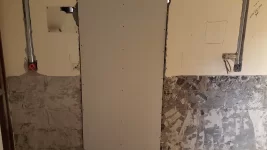Iswear2cow
New Member
Hi guys
Been following the forum for tips for a while. Now it's my turn to seek advice.
I'm doing some metre high flood work. I've a couple of walls where doorways have been partitioned and plasterboarded so have came up with the problem. What do you think the best way to link the plasterboard to the sand and cement.
Imagine a square wall with plaster knocked off a metre high and a doorway in the middle that's been studded out and plasterboarded 10mm or so shy of the existing plaster.
Any advice appreciated.
Thank you.
Been following the forum for tips for a while. Now it's my turn to seek advice.
I'm doing some metre high flood work. I've a couple of walls where doorways have been partitioned and plasterboarded so have came up with the problem. What do you think the best way to link the plasterboard to the sand and cement.
Imagine a square wall with plaster knocked off a metre high and a doorway in the middle that's been studded out and plasterboarded 10mm or so shy of the existing plaster.
Any advice appreciated.
Thank you.

